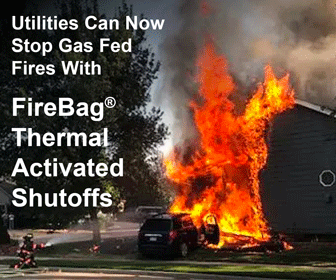When Gas Meters and Regulators Fail in Fire Situations
FireBag Thermal Activated Shutoffs (TAS) significantly reduce the fire dangers posed by regulator or gas meter failures, ensuring a safer environment for first responders and the community.
In This Article
1. Executive Summary
Natural gas distribution systems are critical infrastructure components that supply energy to residential, commercial, and industrial consumers. However, in fire situations, gas meters and regulators can and do fail, and consequently add high-energy fuel to the fire. Occupants and first responders are put at increased risk of injury and death.
The flow of gas to the structure needs to be turned off as quickly as possible when the heat of a fire threatens gas regulators and meters. Manual shutoffs have proven to be totally inadequate. The intensity of the gas-fueled fires makes manual service line valves inaccessible. Yet shutting a distribution line valve installed in accordance with 49 CFR 192.181 or excavating the pipe can and do take hours, as it has in the catastrophic Silver Spring, Maryland on August 16, 2016 fire.
Fire Safety Valves, also known as Thermal Activated Shutoffs, significantly reduce the time to shut off gas to the structure. Installed above ground prior to the regulator and gas meter, Fire Safety Valves automatically shut off high-pressure gas supplies when a meter set is impacted by fire. When the fusible alloy in the Fire Safety Valve melts, a plug is released, automatically shutting the flow of gas. The FireBag Thermal Activated Shutoff automatically closes within 60 seconds with no manual intervention, as per the DIN 3586 internatinal standard. These proven fire safety devices are inexpensive, easy to install, and maintenance free.
This report examines the causes and consequences of such failures, highlights the dangers associated with high-pressure gas leaks, and proposes a solution: the installation of thermally activated shutoffs prior the regulator. Given the significant safety benefits, the Pipeline Safety Trust recommends that widespread use of Fire Shutoff Valves and is advocating for federal regulations, making their use mandatory.
2. Gas Meter and Regulator Failures in Fire Situations
Gas meters and pressure regulators are designed to control and measure the flow of natural gas. However, during fire incidents, these components fail due to extreme heat, mechanical damage, or material degradation. Some of the primary failure mechanisms include:
2.1. Thermal Stress and Component Degradation
- High temperatures in fire situations can weaken and melt plastic or metal components within gas meters and regulators, leading to failure, and the release of high-pressure gas.
- Thermal expansion of materials can also lead to leaks, creating additional safety risks to customers and first responders.
2.2. Overpressure Scenarios
- If a regulator fails, excessive gas pressure from the upstream pipeline may be transmitted directly to the downstream system, causing additional failures and leaks.
2.3. Mechanical Damage from Explosions or Structural Failures
- Fire-induced structural collapses can physically damage gas meters, breaking pipelines and causing significant leaks.
- Explosions resulting from gas ignition can further compromise surrounding gas infrastructure.
3. Risks of High-Pressure Gas Releases in Fire Situations
Natural gas is delivered to customers at high pressure, making the gas service regulator a critical safety component in the delivery network. This device safeguards customers and their premises by controlling the immense energy that could flow through the service line.
However, these regulators, installed above ground, are highly vulnerable to numerous hazards — especially fire. Constructed primarily of aluminum, plastic and rubber, gas regulators and meters fail under the heat of a fire. When they fail, they release high pressure gas, fueling dangerous fires.
When natural gas is released under high pressure due to a regulator or meter failure, escalating hazards emerge:
3.1. Fire Intensification
- The fire continues to burn, until the utility company intervenes, which may take well over an hour.
- Class B fires taht are fueled by natural gas are far more dangerous to occupants, first responders and the general public than the original Class A fire, fueled by ordinary combustibles such as wood, paper, cloth. Class B fires typically burn hotter and spread faster than Class A fires, posing greater risks to occupants and first responders.
3.2. Increased Threat to First Responders
- Firefighters and emergency personnel face greater risks when dealing with uncontrolled gas release, especially when the gas is released at high pressure.
3.3. Environmental and Community Impact
- Widespread gas-fed fires can displace residents and cause economic losses.
- Emergency evacuations and service interruptions may occur, leading to increased public safety concerns.
4. Structural Fires Involving Natural Gas
Unfortunately, we do not have data on how many structural fires resulted in damaged gas meters or regulators. Currently the U.S. Fire Administration’s National Fire Incident Reporting System (NFIRS), does not track fire damage to gas regulators or meters.
5. Case Studies
Examples of gas fed fires emanating from the meter sets include:
South River, NJ
In this fire the building has burned completely to the ground, yet the gas-fed fire continues to burn — waiting for the Gas Utility to excavate and cut off the gas supply.
Modesto CA fire high risk to first responders
Firefighters face significant risk as they work to contain the gas fire venting from a failed regulator, preventing the fire from consuming the entire building.
Flower Branch fire, Silver Springs MD
In this incident, large, high-pressure gas-fed the fire and halted rescue efforts for one hour – the time it took for the gas company to respond and shut off gas systemTragically, seven people died, including two young boys, and over 60 were injured. The primary cause of fatalities was the gas-fed fire.
In addition to the above well-documented cases, Congressperson Laura Friedman representing California’s 30th Congressional District described in graphic detail the unconstrained release of natural gas during the 2025 Los Angeles fires, at the U.S. House of Representatives hearings on February 25, 2025: Committee on Transportation and Infrastructure’s subcommittee on Railroads, Pipelines, and Hazardous Materials. In her testimony, having witnessed natural gas-fed plumes of fires emanating from several thousands of burned-out houses, she questioned why the supply of natural gas continued to fuel fires two and three days after the houses were consumed. She described victims navigating between 7 to 8 feet tall walls of flame, even after the structures were gone. These towers of fire were buffeted by winds, spreading fires to other structures. Congressperson Friedman further advocated for robust standards to automatically stop gas flow to structures in such fire situations, as well as improve pipeline safety.
6. Testing
The Fire Solutions Group. LLC recently conducted live testing of gas meter sets in simulated structure fire conditions at the York County Fire Academy in Pennsylvania in 2024. In every test gas regulators and meters failed, releasing high volumes of gas at significant velocity. The gas-fed fires were powerful, making them highly dangerous for first responders. The shutoff valve, often located on the gas Riser near the meter, becomes inaccessible during a fire once the gas regulator and meter are compromised.
7. Solution: Fire Safety Valves / Thermal Activated Shutoffs Installations Before the Regulator
The TECO® FireBag® thermally activated shut offs (TAS) are essential safety devices used globally in fuel gas systems. Designed to automatically close during high temperature events, the thermally activated shut off device prevents gas from venting into fires by shutting off the supply — BEFORE regulator failure occurs. Installed upstream of the gas regulator the FireBag Fire Safety Valve provides a reliable means to protect property and public safety — while creating a safer environment for emergency personnel to manage fires and evacuations.
8. How Fire Safety Valves, also known as Thermal Activated Shutoffs Work
- When exposed to fire, the fusible alloy triggers a spring, causing the plug to form a gas-tight seal.
- The FireBag’s triggering temperature is +203°F to +212°F (+95°C to +100°C). When the ambient temperature rises to this temperature range, the alloy melts, releasing a spring.
- Once activated, the FireBag shutoff blocks the flow of gas, preventing further leaks and reducing the risk of explosions.
- This simple maintenance-free solution requires no power, actuators or external heat detectors, relying solely on heat exposure to activate.
- Once triggered, the FireBag TAS remains closed, requiring replacement before the gas supply can resume.
- FireBag Thermally activated shut offs are suitable for both indoor and outdoor installations. They have a working temperature from -40˚F to +176˚F (-40˚C to 80˚C).
- The FireBag maintains its integrity for temperatures as high as 1,700˚ F (927˚ C) for 60 minutes at 150 PSI Maximum Allowable Operating Pressure (MAOP). The FireBag has been tested and certified to meet the DIN 3586 international standard, and exceeds the 100 PSI MAOP minimal requirement.
- Whether for single or multiple meter setups, the FireBag is most effective when installed upstream of the regulator, or indoors just inside the building wall, protecting regulators and meter sets.
As seen by this video of a demonstration conducted in Pennsylvania, the Thermal Activated Shutoff activation is audible and the fire is immediately extinguished as the fuel source is cut off.
9. Advantages of Thermal Shutoff Valves
- ✔ Prevents Release of Gas in Event of a Fire – Stops gas flow before it can contribute to a fire or explosion.
- ✔ Protects First Responders – Reduces the hazard of sudden high-pressure gas leaks during firefighting operations.
- ✔ Enhances Community Safety – Limits the potential spread of a gas-fueled fire in residential and commercial areas.
- ✔ Low Maintenance and Reliable – Does not require external power sources and remains functional that lasts as long as the pipeline.
- ✔ Affordable Investment: When installed at the time of the service line installation or upgrade, the Thermal Activated Shutoffs add less than 2% to the typical service line and meter installation cost.
- ✔ Easy to Install: The fittings come in a choice of thread configurations for easy adaptation into any meter set design.
- ✔ Regulatory Compliance: Addresses higher-risk threats and consequences in alignment with DIMP requirements.
- ✔ Long-Term Cost Savings: Reduces risks of catastrophic incidents, repairs, litigation, evidence destruction, and penalties.
10. Conclusion and Recommendations
The failure of gas meters and regulators during fire incidents poses significant safety threats due to high-pressure natural gas release. These failures can intensify fires, and endanger both first responders and the public.
To address this issue, the installation of thermally activated shutoff valves before the regulator should be mandated in gas distribution networks. This safety measure would effectively shut off the gas supply in fire situations, enhancing overall public and firefighter safety. Regulatory bodies, gas utilities, and infrastructure planners must prioritize implementing such safety devices to minimize risks associated with uncontrolled gas leaks.
Significantly, the Pipeline Safety Trust recommends and supports the installation of Fire Shutoff Valves in gas distribution systems.
By implementing thermal-activated shutoff valves, we can significantly reduce the fire dangers posed by regulator or gas meter failures, ensuring a safer environment for first responders and the community.
Share This Article
Resources
Contact Us Today!
All information is confidential and sent directly to a TECO Americas representative.
TECO® Americas, LLC
263 Cox Street Roselle, NJ 07203
inquiry@tecoamericas.com
Phone: 908-488-0909
https://tecoamericas.com



